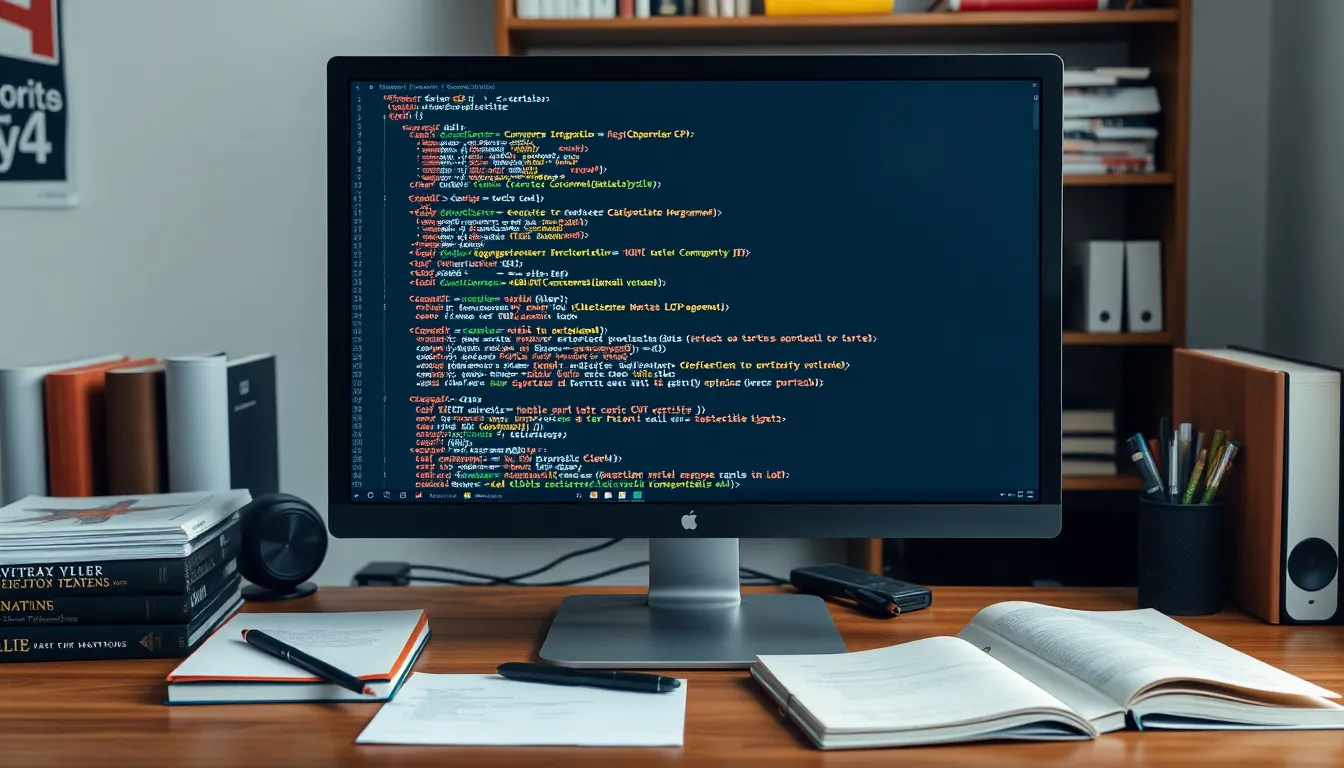Printing in C++ might sound as thrilling as watching paint dry, but it’s actually the gateway to unleashing your programming creativity. Whether it’s displaying a simple message or debugging your code, knowing how to print is essential for every budding programmer. After all, what’s the point of writing code if you can’t show off your genius to the world?
Table of Contents
ToggleUnderstanding Output in C++
Output in C++ is fundamental for both representation and debugging. It allows programmers to communicate results effectively and gain insights during code execution.
The Importance of Printing in Programming
Printing serves as a critical tool in programming. It helps in conveying important data to users, making applications interactive. During debugging, print statements enable developers to trace errors and understand the program’s flow. Programmers frequently utilize print statements to confirm that variables contain expected values. Furthermore, they visualize output, which enhances the user experience by providing feedback on processes. Overall, effective output management remains essential for developing robust applications.
Where to Start with Printing
Getting started with printing in C++ involves using the standard output stream. Developers typically begin with the cout object from the iostream library. To display a message, a simple statement like cout << "Hello, World!"; works well. This statement sends data to the console for the user to see. Additionally, using cin allows for input capture, complementing the output function. Programmers should also explore manipulating output format using manipulators like std::endl or std::fixed. Overall, these initial steps set a strong foundation for effective output handling in C++.
Basic Printing Techniques

Printing in C++ involves several techniques for displaying output effectively. Mastering these techniques enhances the programmer’s ability to convey messages and debug code.
Using cout for Console Output
Using cout for console output represents the primary method for printing in C++. Programmers can easily display text and variables by employing cout along with the insertion operator <<. For example, the statement cout << "Hello, World!"; outputs a simple greeting. Displaying multiple data types is straightforward; just chain them with <<, such as cout << "Value: " << variable;. This technique allows the printout of integer, floating-point, and string values in a single line effortlessly. Additionally, including std:: is necessary if the using namespace std; directive is not included. Understanding cout streamlines output operations in C++ significantly.
Formatting Output with Manipulators
Formatting output with manipulators in C++ provides flexibility and control over how data appears. Common manipulators include std::endl, which adds a newline and flushes the output buffer, and std::fixed, which alters the precision of floating-point numbers. For instance, using cout << std::fixed << std::setprecision(2) << value; formats the value to two decimal places. Other useful manipulators, like std::setw, adjust the width of the output field, aiding in aligning output for better readability. Choosing the right manipulators enhances the presentation of console output, making it more user-friendly.
Advanced Printing Methods
Advanced printing methods in C++ enable developers to enhance their output capabilities significantly. These techniques allow for greater control over how data is presented and stored.
Printing to Files
Printing output to files expands the use of C++. Programmers can utilize the ofstream class for file output operations. This capability facilitates the creation of text files that can store important data, such as logs or reports. To print to a file, a programmer first creates an ofstream object and opens a desired file. For example:
std::ofstream file("output.txt");
file << "Text to save in a file.";
Using this approach, data can be efficiently redirected from the console to a file. Closing the file afterward ensures data integrity and proper resource management.
Customizing Output Streams
Customizing output streams provides flexibility in formatting. C++ allows developers to manipulate stream behavior through various techniques. They can define custom output formats using the stream manipulators, such as std::setw for setting width and std::setprecision for controlling the number of decimal places. An example of this includes:
#include <iomanip>
std::cout << std::fixed << std::setprecision(2) << 123.456;
This code snippet demonstrates control over decimal representation, ensuring better readability. Utilizing custom output streams enhances the presentation of information and caters to user needs.
Common Mistakes to Avoid
Printing in C++ can pose challenges if users aren’t careful. Improper use of the insertion operator can lead to syntax errors. Programmers often forget to include the right header file, which is necessary for using cout and cin. Without #include <iostream>, the program won’t compile successfully.
Neglecting to end statements with a semicolon is another common mistake. Each line of code that performs an action requires a semicolon to indicate its conclusion. Skipping this may confuse the compiler, leading to frustrating error messages.
Not managing the output format properly can result in unreadable data. Instead of displaying a cluttered output, users should utilize manipulators for clearer presentation. Failing to apply manipulators such as std::endl can lead to output appearing on a single line, making it challenging to read.
Additionally, when printing variables, ensuring the correct data type is crucial. Casting issues frequently arise when attempting to print mixed data types. For instance, trying to combine integers and strings without appropriate conversion may cause runtime errors.
Another frequent pitfall involves omitting file handling syntax when working with output files. Always remember to close output streams, as this step prevents data loss. Without proper handling, the output data might not be saved as intended.
Lastly, overlooking error-checking mechanisms can lead to silent failures. Implementing checks for successful file opens and error messages ensures smoother program execution. Debugging becomes easier with proper feedback from print statements when issues arise.
Recognizing and addressing these common mistakes enhances the efficiency of printing in C++. By focusing on these key areas, programmers can improve their output handling in C++, leading to a more effective coding experience.
Printing in C++ is more than just displaying text; it’s an essential skill for effective programming. By mastering the use of cout and understanding various output techniques, programmers can enhance their applications and improve the user experience. From simple console output to advanced file handling and custom formatting, the ability to communicate through print statements is vital for debugging and showcasing creativity.
Avoiding common pitfalls ensures smoother execution and clearer communication of data. With these skills, developers can confidently navigate the complexities of output handling in C++. Embracing these techniques will lead to more robust applications and a deeper understanding of C++ programming.


